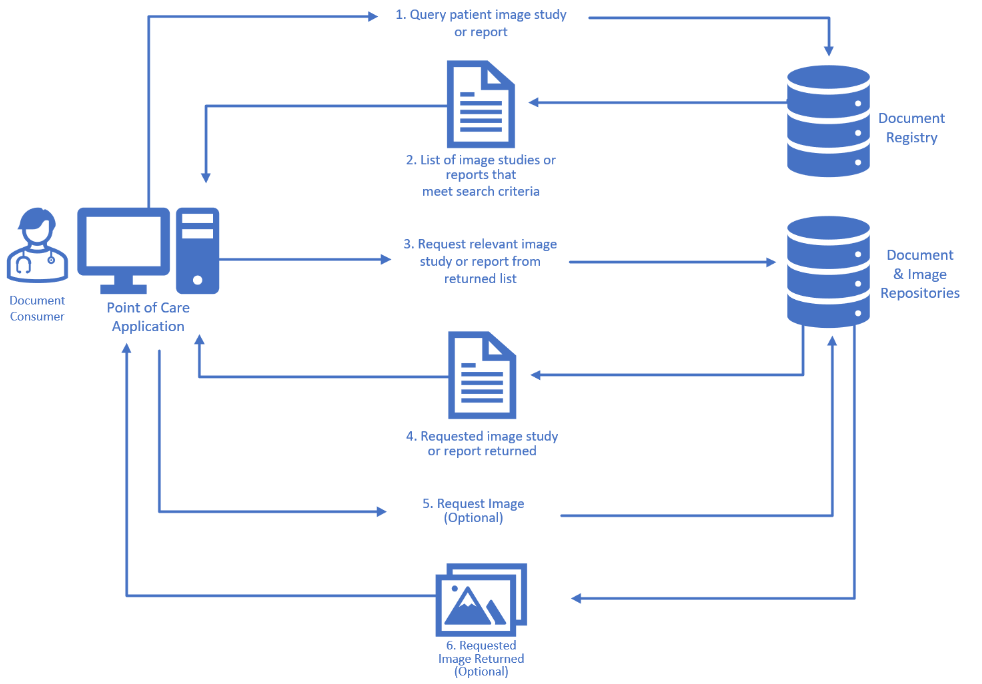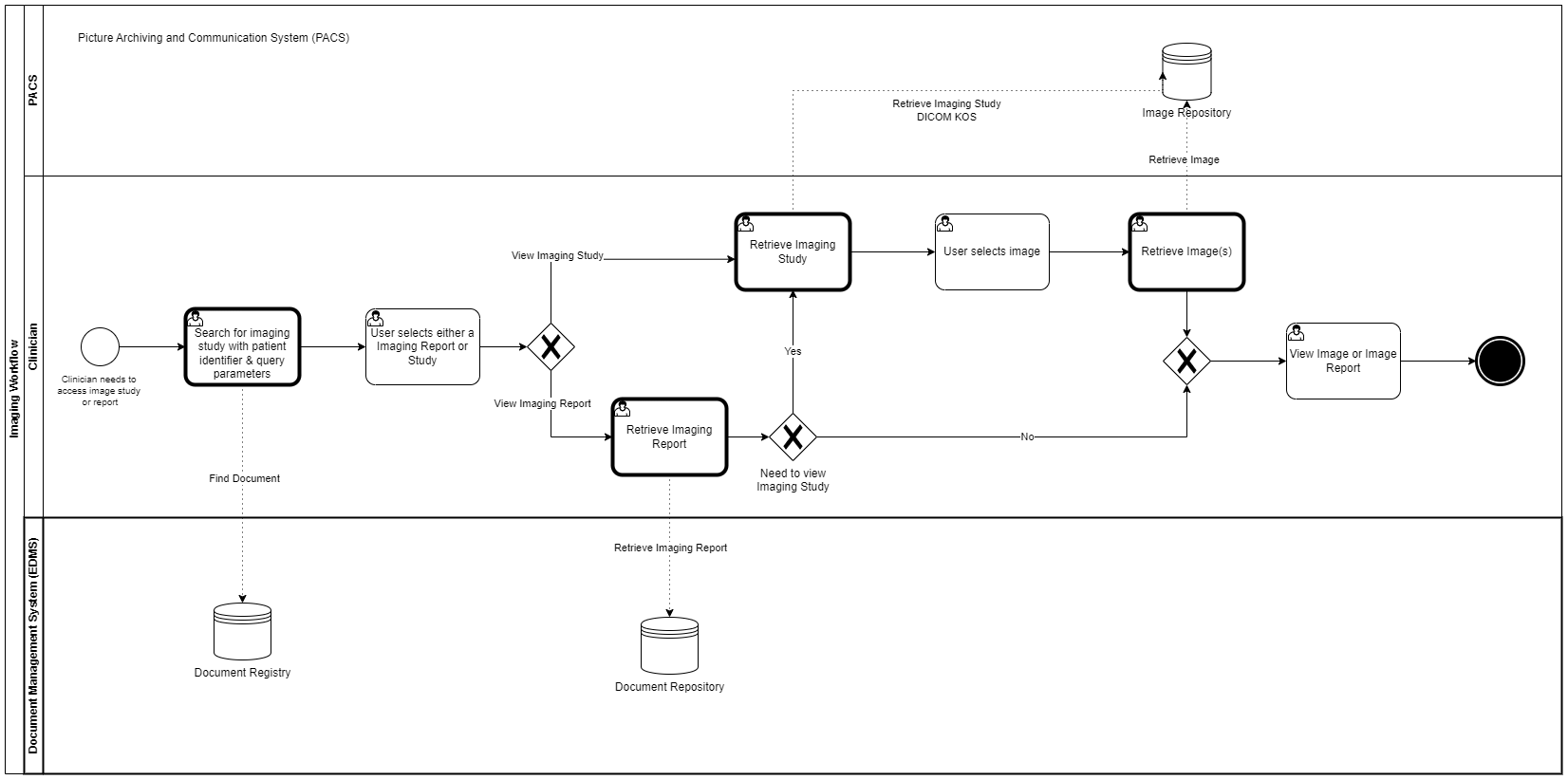Radiology (Sandbox)
0.0.1-current - ci-build
Radiology (Sandbox)
0.0.1-current - ci-build
Requirement Specification
This is for collaboration and discussion purposes and is subject to change.
This is not an Implementation Guide
Radiology (Sandbox) - Local Development build (v0.0.1-current) built by the FHIR (HL7® FHIR® Standard) Build Tools. See the Directory of published versions
NHS Radiology faces significant challenges in enabling inter-organisational access to patients’ historical diagnostic images and reports, which is crucial for ensuring continuity of care. The current reliance on the Image Exchange Portal (IEP) to share imaging studies across Trusts or Imaging Networks is fraught with inefficiencies, leading to delays and frustration for clinicians. These limitations result in unnecessary patient re-imaging and resource wastage, costing approximately £4 million annually. A solution is needed to provide seamless access to historical radiological imaging studies across all hospital sites, regardless of where the study was originally conducted.
| Term | Definition |
|---|---|
| DICOM | Digital Imaging and Communications in Medicine is the global standard for medical images developed by American College of Radiology (ACR) and National Electrical Manufacturers Association (NEMA). |
| Imaging Report | An imaging report reflects the observations and interpretations of one or more imaging studies. It usually contains elements such as the reason why the study is requested, relevant contextual medical information, the used modality and its settings, procedures and body localisations that were used, a description of the observations and findings, exposure information, conclusion and advice. |
| Imaging Study | An imaging study comprises a set of objects, including images and other objects, that were made for a specific purpose and usually in response to a request from a healthcare provider. The Imaging Study does not include the Imaging Report as defined in this guideline. Imaging Study in this context does not refer to the FHIR Resource ImagingStudy - FHIR v4.0.1 (hl7.org) |
| PACS | Picture Archiving and Communication System. A PACS consists of three major components: a secure network for the transmission of imaging and patient information, workstations for interpreting and reviewing images, and archives for the storage and retrieval of images and reports. Combined with web technology, a PACS has the ability to deliver timely and efficient access to images, interpretations, and related data. A PACS is usually linked to a Hospital Information System. |
| RIS | Radiology Information System. The main functions of a RIS are the patient scheduling, resource management, examination performance tracking, reporting, results distribution, and procedure billing. Typically, it is integrated in the HIS and the PACS. |
| Actor | Description |
|---|---|
| Document Registry | The Document Registry Actor maintains metadata about each registered document in a document entry. This includes a link to the Document in the Repository where it is stored. The Document Registry responds to queries from Document Consumer actors about documents meeting specific criteria. |
| Document Repository | The Document Repository is responsible for both the persistent storage of these documents (e.g. Imaging Report) |
| Image Repository | The Imaging Repository is responsible for both the persistent storage of DICOM Images and Imaging Studies, these may also contain Imaging Reports. This is also known as a PACS. |
| Document Consumer | The Document Consumer Actor queries for documents meeting certain criteria, and may retrieve selected documents. |
Actor Diagram

Process Diagram
| Name | Searching and Retrieving an Image |
| User Story Summary (Clinical Overview) | As a clinician working in cancer treatment, I can search for and retrieve imaging studies and/or reports for a patient, So that I can make informed clinical decisions and provide effective healthcare for my patient. |
| Actors (Role) | Secondary and Tertiary Care Worker, Image repository, Healthcare System |
| Frequency of Use | Whenever access to image study and/or report is required |
| Triggers | Clinician needs to access image study and/or report for a patient |
| Pre Conditions | 1. Clinician must have access to the healthcare system with appropriate permissions. 2. Patient’s imaging studies and reports must be stored and accessible within the system. |
| Post Conditions | 1. Clinician successfully retrieves and views the relevant imaging studies and reports. 2. System logs the access and retrieval of patient records for auditing purposes. 3. Clinician uses the retrieved information to inform diagnosis and treatment planning, enhancing patient care. 4. Any necessary follow-up actions are scheduled based on the retrieved imaging studies and reports. |
| Main Course | 1. Clinician wants to search for and retrieve a patient’s radiology image: - Clinician identifies the need to access previous imaging studies and reports. 2. Clinician queries system for a list of imaging studies and reports for patient: - Clinician enters the patient’s identifier. - Clinician provides additional query parameters, such as time period, modality, study procedure, body part, or procedure code, if needed. 3. List of imaging studies and/or reports returned to clinician: - System displays a list of imaging studies and reports matching the query parameters. 4. Clinician selects (including filtering, ordering, grouping) and requests the relevant imaging studies and/or reports: - Clinician reviews the list, applies any necessary filters, orders or groups the results, and selects the relevant studies and/or reports. 5. If required, after clinician has reviewed imaging report they can retrieve the relevant imaging study 6. The requested imaging studies and/or reports are sent to the clinician. In case there are multiple versions of studies/reports, the latest versions are provided: - System retrieves the selected studies and/or reports, ensuring the latest versions are included, and sends them to the clinician. 7. Clinician is presented with the requested imaging studies and/or reports: - Clinician views the retrieved imaging studies and reports on their interface. 8. Clinician uses the imaging studies and/or reports to provide healthcare service: - Clinician reviews the images and reports to inform diagnosis, treatment planning, or other healthcare decisions. |
| Alternate Course | 1. Clinician refines the search with additional unique patient identifiers or search criteria to ensure the correct patient records are retrieved, if not initially successful |
| Exception | 1. System does not find any imaging studies or reports for the patient. 2. System returns records for multiple patients with similar identifiers. 3. System encounters an error while retrieving the requested reports. |

Process Diagram
The National Imaging Registry will have two alphas. To an external user they will look very similar and both allow access to all imaging reports, studies and images across the English NHS.